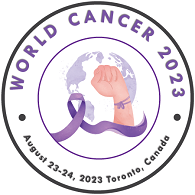
Yifan Li
Shanxi Province Cancer Hospital, Taiyuan, China
Title: The role of chemotherapy cycles in treament of gastric cancer should be reinterpreted
Biography
Biography: Yifan Li
Abstract
We retrospectively reviewed the medical records of patients with pathologically confirmed gastric cancer who underwent curative surgical resection follow-up within 3 years at Shanxi cancer hospital between 2002 and 2020. According to the results of univariate and multivariate analysis by logistic regression showed that TNM Stage(P=0.002), chemotherapy cycle(P=0.000) were risk factors of recurrence of follow-up within 3 years. The results of the univariate and multivariate by Cox regression were clearly presented that T Stage(P=0.000), TNM stage(P=0.001), maximum diameter of tumor(P=0.001) were risk factors of overall survival of follow-up within 3 years. If we attached much importance to insure chemotherapy cycle adequately performance, the overall survival rate may be significantly improved. At the same time, maximum diameter of tumor can be reduced through complete chemotherapy implement. Finally, overall survival ratio of follow-up within 3 years may be enhacedenhanced by this measure. And then, we develop novel nomograms to accurately predict overall survival (OS) of chemotherapy cycles<9 and chemotherapy cycles≥9 and construct risk stratification to differentiate low-risk and high-risk of two cohorts . Nomograms predicting 3- and 5-year OS were built according to variables resulting from multivariable Cox models. Discrimination ability was calculated using the Harrell’s Concordance Index. The constructed nomogram was subjected to 1,000 resamples bootstrap for internal validation. Calibration curves for the new nomograms were used to test the consistency between the predicted and actual 3- and 5-year OS. Decision curve analysis (DCA) was performed to assess the clinical net benefit. The Concordance index (C-index) and time-dependent receiver operating characteristic (t-ROC) curves were used to evaluate and compare the discriminative abilities of the new nomograms. Finally, prognostic risk stratification of gastric cancer was conducted with X-tile software and nomograms converted into a risk-stratified prognosis model. For the nomogram predict OS of chemotherapy cycles <9, C-index was 0.711 (95%CI: 0.663-0.760) in internal validation and 0.722(95%CI:0.662-0.783) in external validation, which was better than AJCC 8th edition TNM staging (internal validation:0.627 ,95%CI: 0.585-0.670) and (external validation:0.595,95%CI:0.543-0.648). The C-index of the nomogram for chemotherapy cycles≥9 in internal validation was 0.755 (95%CI: 0.728-0.782) and 0.785(95%CI:0.747-0.823) in external validation, which was superior to the AJCC 8th edition TNM staging (internal validation: 0.712 95%CI: 0.688-0.737) and (external validation 0.734, 95%CI:0.699-0.770). Chemotherapy cycles≥9 is therefore recommended for high-risk patients with chemotherapy cycles <9, but not for low-risk patients. Meanwhile, combination with multiple therapies are essential to high-risk patients with chemotherapy cycles ≥9 and unnecessary for low-risk patients. We retrospectively evaluated 412 patients of stageâ…¡ and 902 patients with stageâ…¢ gastric cancer who underwent D2+gastrectomy plus adjuvant chemotherapy or neoadjuvant chemotherapy. Propensity score matching (PSM) analysis was performed with a 1:1 ratio to reduce the real-life baseline difference between the two groups. After PSM, the baseline characteristics were similar between the two groups for stageâ…¡and â…¢. Kaplan-Meier analysis showed that no difference was observed in OS (stage â…¡:HR 0.856, 95%CI 0.454-1.612; P = 0.630, stage â…¢: HR=1.175, 95% CI: 0.926–1.492, p=0.173) or PFS (stage â…¡:HR 0.694, 95%CI 0.409-1.177; P = 0.173, stage â…¢: HR=0.934, 95% CI: 0.658–1.025, P=0.074) between the two groups. The overall recurrence(P<0.001), local-regional metastasis (P=0.002), distant metastasis(P=0.001) rates in chemotherapy cycles≥9 group were significantly lower than in the chemotherapy cycles<9 group for stage â…¢. The interaction analysis by Cox proportional hazard regression model showed that intestinal type, proximal gastrectomy, maximum diameter of tumor≥6cm had higher risk of total mortality in group of chemotherapy cycle<9. As a whole, chemotherapy cycles≥9 is unnecessary for patients with stageâ…¡ and stage â…¢ owing to its insignificant role in prognosis of gastric cancer. On the other side, chemotherapy cycles≥9 has a major part to play in avoiding recurrence of patients with stage â…¢, except for the role in stageâ…¡.

